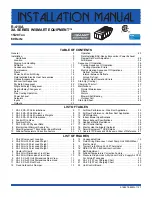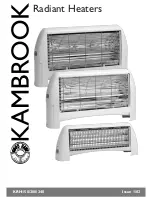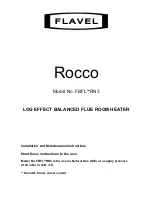
7
LEAKAGE CHECKPOINTS
INSTRUCTIONS:
USE THIS ILLUSTRATION AS A GUIDE WHEN CHECKING FOR SOURCES OF WATER LEAKAGE.
YOU OR YOUR DEALER MAY BE ABLE TO CORRECT WHAT APPEARS TO BE A PROBLEM.
Water leaks at the elements may be due to:
1.
Defective element which leaks at termi-
nals or thru flange. Replace element*.
2.
Loose element/gasket leak:
(a) Screw-in type: tighten with 1 1/2"
socket wrench or Part No. 21163 or
23985 wrench. If leak continues, re-
move element*, discard gasket and
clean thread areas. Apply non-hard-
ening Permatex No. 2 to thread areas,
install new gasket and screw element
into fitting until it seats. Tighten 1/2 to
3/4 turn with wrench.
(b) Flange type: tighten screws with
wrench. If leak continues remove el-
ement* and discard gasket. Clean
gasket seating areas and re-install el-
ement with new gasket.
NOTE: Part No. 40000-1 scale cleaning
replacement screws available where
threads have become rusted or damaged,
preventing tightening.
Where possible, remove or lift top cover
to examine threads of fittings installed into
tank for evidence of leakage. Correct fit-
ting leaks as necessary.
Condensation and dripping may
appear on pipes when cold wa-
ter temperature is low. Pipe fit-
ting may be leaking.
Water on the side of the tank may be
condensation due to the panel or in-
sulation not being in place.
Drain valve leakage could be from the
valve itself. Either correct the problem
or replace the valve.* To check for
leakage where threaded portion enters
tank, insert Q-tip or similar absorbent
material between jacket opening and
valve to swab spud area. Remove
valve* if leak is indicated and repair
with pipe joint compound.
* Contact your dealer as it is necessary
to shut off electricity and drain tank to
perform procedure.
To Open Drain
Anode Rod
Temperature & Pressure
Relief Valve
Cover and Insulation
shown removed
to reveal tank top
To Open Drain
Relief valve operation and leakage may
be due to water expansion during heat-
ing cycle or foreign material on seat of
valve. If the valve is not piped to an
open drain the released water could be
mistaken for a leaking heater. To check
where threaded portion enters tank,
insert Q-tip or similar absorbent mate-
rial between jacket opening and valve
to swab spud area. Remove valve* if
leak is indicated and repair with pipe
joint compound.
All water which appears at the heater bot-
tom or on the surrounding floor may be
caused by condensation, loose connections
or relief valve operation and leakage. Do
not replace the heater until a full inspection
of all potential leak points is made and cor-
rective steps taken to stop the leak. Leak-
age from other appliances, water lines or
ground seepage should also be suspected
until proven otherwise.


























